|
Visiting
Planeta
One of Sicily's leading producers
Website:
www.planeta.it
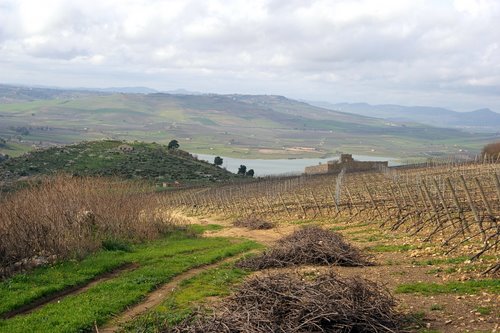
Sicily
has a lot of vineyards. It’s the second largest wine region in
Italy, and has about the same area under vine as South Africa or
Chile, with 120 000 hectares of vineyards (I bet you didn’t know
this). It is the proud possessor of 23 DOCs and a sole DOCG (Cerasuolo
di Vittoria), although some of these DOCs are for fortified and
sweet wines, not table wines.
But
Sicily is only just beginning to establish a reputation for fine
wines. Planeta is one of the most significant producers in this
regard: a large, modern producer with a good reputation
internationally for its wines, with wineries in Sambuca, Menfi
(two), Vittoria and Noto, and a new project in Mount Etna.
Altogether, Planeta now have an impressive 390 hectares of vines.
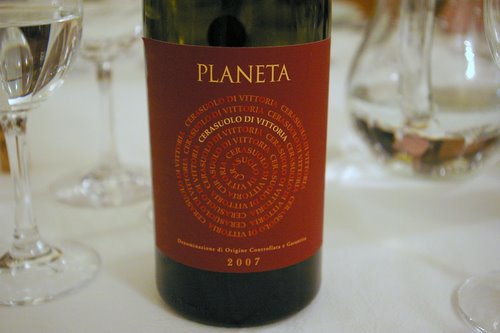
Along
with fellow writers Simon Woods and Olly Smith, I visited Planeta’s
various wineries and vineyards in a whistle stop tour of Sicily. We
met with three members of the Planeta family: Francesca and her
cousin Alessio, and also Diego Planeta, father of the former, uncle
of the latter – the visionary figure behind both Planeta, and also
the impressive Settesoli cooperative, which he is president of.
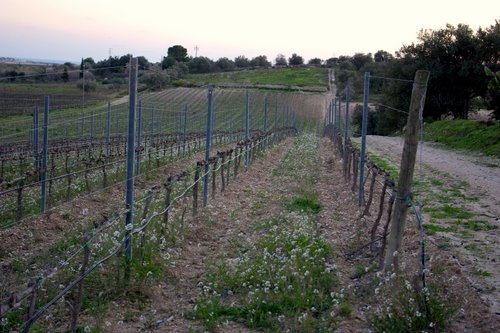
We
began in Noto (above), in Buovino. Planeta make just two
wines here from their 60 hectares of vines, Nero d’Avola and
Moscato di Noto (an unfortified sweet wine, now referred to
officially, since 2008, as Passito di Noto DOC). Planeta built their
Cantina Invisible winery here (below), sunk into the ground,
in 2002/3, and this turned out to be an expensive project. This is
where Planeta’s Nero d’Avola-based red Santa Cecilia is made.
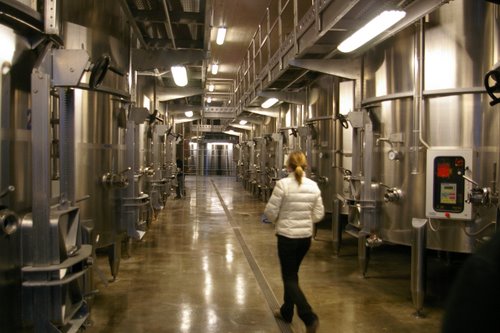
Alessio
Planeta speculates that Muscat may have been the original white
grape variety moving around in the ancient world, and that this
might have been the first variety to reach Sicily. The grapes for
this wine are dried for a month and a half in 5 kg cases in a
low-temperature room. In antiquity, the grapes would have been cut
and leaves placed over the bunches outside to protect them from the
sun while they were drying. Fermentation slows and then stops
naturally leaving a lot of residual sugar.
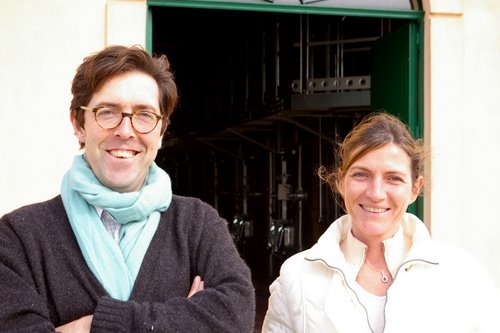
Alessio and Francesca Planeta
Planeta
Passito di Noto DOC 2008 (tank sample)
Grapes are picked ripe then dried for 45 days. 190 g/l residual
sugar. Really aromatic and fresh. Grapey, sweet and herby: viscous
and rich-textured with spicy, lemony freshness. Sweet and intense
but with lovely acidity.
Planeta
Moscati di Noto 2007
Powerful, grapey and citrussy with lovely richness and high
acidity. There’s some marmaladey freshness; this is a lively wine.
91/100
Planeta
Moscati di Noto 2006
Rich, intense, grapey and spicy with lovely viscous texture.
There’s a nice combination of floral freshness with tropical fruit
richness. Fresh and lively. 91/100
Planeta
Santa Cecilia Nero d’Avola 2008 (barrel sample)
From a five-year-old vineyard. Very aromatic dark fruits nose
with fresh cherry and spice notes, and some new oak evident (this is
from a new barrel, the final blend is one-third new oak). Very fresh
with lovely definition and bright plum and cherry fruit. The same
wine from an older barrel had a fresh, dark, chocolatey nose that
was bright and sweet. Quite firm tannins. Tight but still fresh.
Francesca
says she’s never seen such a good vintage as 2008 in this
district. There wasn’t too much heat in the summer and the bunches
were in perfect condition. It was dry during harvest. 2007 was a
warmer vintage.
Planeta
Santa Cecilia 2007 IGT Nero d’Avola di Sicilia
Fresh, focused sweet floral aromatics to the cherry fruit nose.
The palate has a hint of oak and a bit of plummy bitterness along
with the fresh focused cherry fruit. It’s a lovely wine, although
I’m not overly keen on the slightly bitter, tarry, earthy notes in
the background. Savoury with bright acidity. 90/100
Planeta
Santa Cecilia 2006 IGT Nero d’Avola di Sicilia
Lovely sweet and sour nose with aromatic sweet black cherry and
blackberry fruit, as well as some fresh, herby, spicy notes. The
palate is bright with good acidity and fresh savoury, spicy
structure. Nice sweet cherry fruit here. 91/100
Planeta
Santa Cecilia 2005 IGT Nero d’Avola di Sicilia
Sweet, pure focused dark cherry and blackberry fruit. Quite
smooth with a polished personality. The palate is fresh, smooth and
has nice dark fruits over a spicy structure. Savoury style. 89/100
Planeta
Santa Cecilia 2002 IGT Nero d’Avola di Sicilia
Pure dark fruits/cherry nose with some restraint. The palate has
earthiness as well as bright cherry and berry fruit. Finishes earthy
and structured. 87/100
Planeta
Santa Cecilia 2001 IGT Nero d’Avola di Sicilia
Very pure, sweet dark cherry fruit nose with brooding, spicy,
meaty complexity. The palate shows lovely earthy backing to the
intense dark fruits. Broad, sweet, spicy and structured. Drinking
very well now. 91/100
Planeta
Santa Cecilia 2000 IGT Nero d’Avola di Sicilia
Deep coloured. Smooth, pure, slightly herbal, restrained dark
cherry nose. The palate shows tight, fresh dark cherry fruits with
some hints of earth and meat. Quite pure and focused with good
purity. 89/100
Planeta
Santa Cecilia 1999 IGT Nero d’Avola di Sicilia
This was the first year when some Noto fruit was included (now
it’s 100% Noto, from 2003 on). Evolved, earthy, spicy nose with
warm spiciness. The palate is fresh, warm and spicy with lots
happening. Earthy and dense with good acidity. 87/100
Planeta
Santa Cecilia 1998 IGT Nero d’Avola di Sicilia
From now on, this is 100% Nero d’Avola. Quite a tight nose
showing some earthy, spicy notes. The palate is fresh and tart with
good structure and nice dark fruit. Ageing better than the 1997.
88/100
Planeta
Santa Cecilia 1997 IGT
This was the first vintage of this wine, and in 1997 this had
15% Syrah in it. Warm, spicy, earthy, herby nose with some evolution
and a hint of mint. The palate is fresh and earthy with a hint of
funk. Elderly, but still has acidity. 86/100
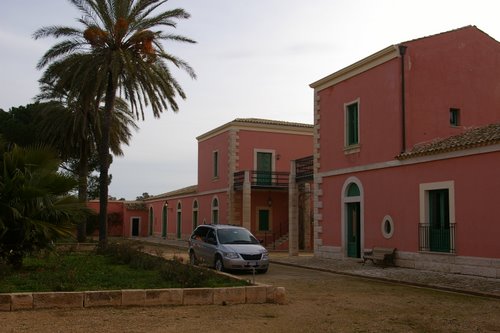
Next stop was Vittoria, where we were to stay for the night in the
converted farmhouse at Dorilli (above). In 1997 Planeta
planted 17 hectares here, following this with a further 20 in 2002.
This is the region where Nero d’Avola and Frappato are blended
together to get Cerasuolo di Vittoria. This is where we met with
Diego Planeta (below), who cooked dinner for us.

Planeta
began in 1985 in Ulmo, which is in Sambuca di Sicilia. 45 hectares
were planted with Chardonnay, Merlot, Cabernet Sauvignon, Nero d’Avola,
Aglianico as well as experiments such as Riesling. 1995 was the
first Planeta vintage, and from 1996 onwards Planeta expanded, with
more experimentation, more vineyards and two new wineries in the
years following (1997 Vittorio and 1998 Noto).
Diego
has always had an experimental tendency, first with the Settesoli
cooperative when he started planting lots of varieties in the early
1980s, and later with Planeta. Altogether, 50–60 varieties have
been trialled. The reason for this experimentation is that there was
general dissatisfaction with the indigenous white Sicilian
varieties, which according to Diego have a problem: none of them can
age.
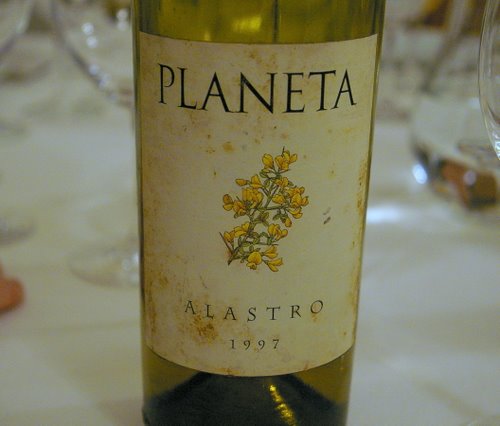
85%
of production in Sicily is white, and the most commonly grown grapes
are Catarrato, Grillo and Trebbiano. ‘Grecanico [aka Garganega] is
the only local variety that can age,’ says Diego, ‘and that’s
the reason we have invested so much in it.’ Diego says that the
indigenous varieties just tend to collapse after a year or two in
bottle, and this is one reason why he has focused also on imports
such as Chardonnay and Fiano (which he brought to Sicily from the
mainland of southern Italy).
Chardonnay
is Planeta’s most successful wine. He says that if the Inycon
wines (a brand from the Settesoli Cooperative that’s popular in
the UK) are labelled by the local varieties, they don’t sell. This
makes it difficult to sell the likes of Grecanico as varietal wines.
‘It is a tremendous barrier,’ says Diego. In 2006 he
commissioned some market research in the UK. It found that while 95%
of people were aware of Sicily the place, only 7% knew it was a
wine-producing region.
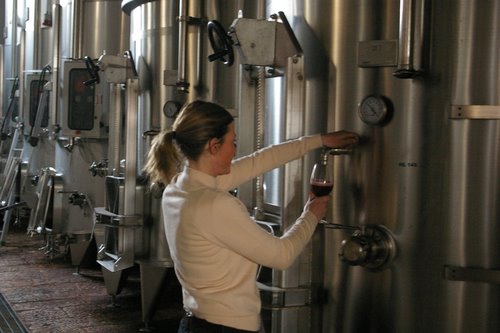
Vittoria
is home to the island’s only DOCG: Cerasuolo di Vittoria. It’s a
blend of Nero d’Avola with Frappato. ‘If you grow Frappato
anywhere else in Sicily it is a disaster,’ says Diego. Here, it is
bright and fresh with lovely cherry fruit and high acidity, as well
as low alcohol. It’s not what you’d expect from a warm climate.
Barrel
samples:
Frappato
2008 Pale and fresh with bright cherry aromatics and high acidity.
Grippy with good acid. Bright and light.
Nero
d’Avola 2008 Deeper colour. Vivid, intense and aromatic with
bright dark cherry fruit and good acidity.
Planeta
Cerasuolo di Vittoria 2007
This is one of my favourites from the Planeta range. Beautifully
perfumed with sweet cherries and a subtle herbiness. The palate is
fresh and quite pure with sweet, rounded fruit and a lovely fresh
spicy cherry character. Fresh and expressive. 92/100
Planeta
Alastro 2007
A blend of Chardonnay (49%) and Grecanico (60%); the Chardonnay
portion sees 10% new oak. Rich, quite tropical nose with a nutty
edge and some minerality. The palate has nice freshness with lemony
zip to the fruit. A rich, full style with a nice pithy, subtly
bitter edge. Real intensity. 89/100
Planeta
Alastro 1997
I was really impressed by how this wine had developed. Deep
yellow colour. Fresh still with nice acidity and deep, nutty, waxy
herby notes. Expressive and evolved but still very much alive.
89/100
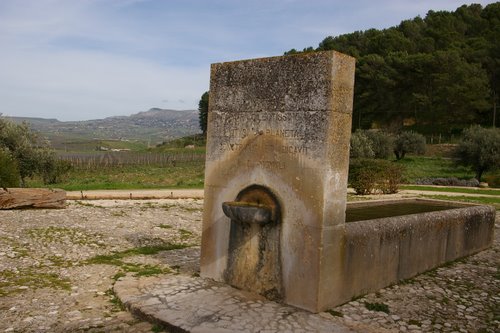
Next
stop was Menfi, the heart of the Planeta operation, where we visited
the Ulmo winery and the surrounding vineyards.
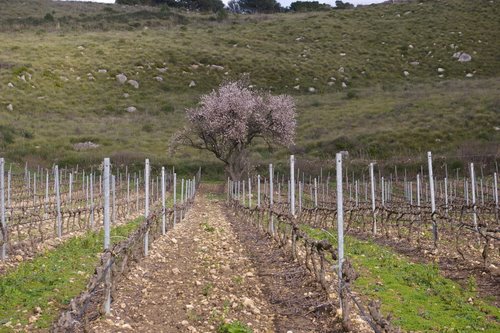
We
looked at some Chardonnay barrel samples. This is an important
variety for Planeta, and they do a very good job with it. Their
Chardonnay can age. They have evolved the style from rich and fat to
a more elegant and fresh one, although it is still quite a rich
wine.
Chardonnay
2008 barrel sample (1) Lemony fresh with lovely complexity and a
nice combination of richness and freshness.
Barrel
sample (2) older vines, planted in 1985/6. Rich, rounded, nutty and
bold with a pithy edge.
(3)
One-year-old barrel. Really round, rich, spicy and nutty with lots
of flavour. Exotic but balanced.
(4)
Same wine, new barrel: vivid, spicy and intense.
(5)
Nutty with a sweet pineapple nose, and a powerful spicy palate.
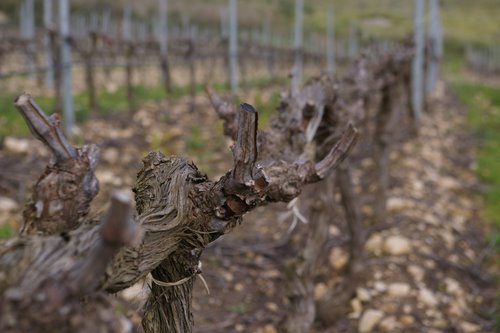
Planeta
Cometa 2008
This is a varietal Fiano – a grape variety Diego Planeta
brought to Sicily from the southern Italian mainland. Tank sample of
final blend (since 2006 the wine has been unoaked). Nutty, intense
and fresh with a lively, bold palate and complex citrussy, herby
fruit. Powerful and rich but fresh at the same time, with nice
elegance and aromas.
Planeta
Cometa 2007
14.5% alcohol. Deep yellow colour. Aromatic, fresh, nutty nose
with some herby, citrus notes, as well as tangerine and apricot. The
palate is rich, concentrated and herby with melon and apricot notes.
Fresh with a hint of smoky complexity, with nice intensity. 91/100
Planeta
Cometa 2001
Lovely fresh style. A bit toasty with nice herbal character.
Complex and rounded with nice melong, spicy characters. Quite bold
and evolving really nicely. 91/100
Planeta
Chardonnay 2007
14% alcohol. Deep yellow/gold colour. Rich, toasty and nutty on
the nose with sweetness and intensity, but also freshness. The
palate is bold and intense with rich nutty notes and hints of
butter, as well as citrus fruits and spice. Stylish. 90/100
Planeta
Chardonnay 1995
Deep yellow colour with a lovely open, toasty nose. The palate
is nutty and evolved with smooth, toasty notes and nice acidity.
Delicious stuff that has aged beautifully. 92/100
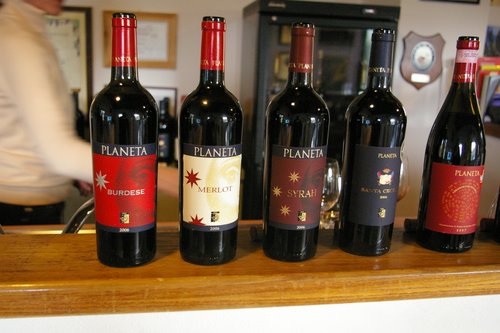
Planeta
La Segreta white 2008
50% Grecanico, 30% Chardonnay, 10% Fiano, 10% Viognier. Crisp,
fresh and bright with a lovely bold, full flavoured palate showing
hints of apricots and herbs. 88/100
Planeta
La Segreta red 2008 (tank sample of final blend)
Lovely bright sweet cherry aromatics with a slightly meaty,
spicy twist. The palate is fresh and fruity with focused plum and
cherry fruit. Delicious. 88/100
Planeta
Rosé 2008
Syrah. Very bright and crisp with some herby notes and just the
faintest trace of strawberry fruit. 87/100
Planeta
Merlot 2006
Lovely pure blackcurrant fruit nose. Smooth with a hint of
tarriness. The palate is fresh and quite pure with good definition
of blackberry and cherry fruit and nice structure. A delicious,
ageable wine. 91/100
Planeta
Merlot 1998 (magnum)
Really fresh and pure, and evolving really nicely. Berryish and
sweet with nice spicy earthy structure. Really nice, fresh and
mineral with a gravelly edge. Ageing beautifully. 92/100
Planeta
Syrah 2006
Sweet aromatic, spicy, herby dark fruits nose with some cherry
freshness. The palate has lovely pure, sweet, almost lush blackberry
and cherry fruit and a hint of spice. Almost Australian in style.
89/100
Planeta
Syrah 2002
Evolved, spicy nose with notes of earth, cedar and spice. Quite
savoury. The palate has nice sweet fruit with open, evolved, spicy
complexity. Interesting stuff. 89/100
Planeta
Burdese 2006
70% Cabernet Sauvignon, 30% Cabernet Franc, aged in new oak.
Lovely sweet, smooth aromatic blackcurrant fruit nose. Pure,
aromatic and intense – quite profound. The palate is fresh and
pure with ripe, sweet fruit. Nicely focused and well defined. 93/100
See
also:
 Visiting
Chianti Classico (series) Visiting
Chianti Classico (series)
Wines
tasted 02/09
Find these wines with wine-searcher.com
Back
to top
|

